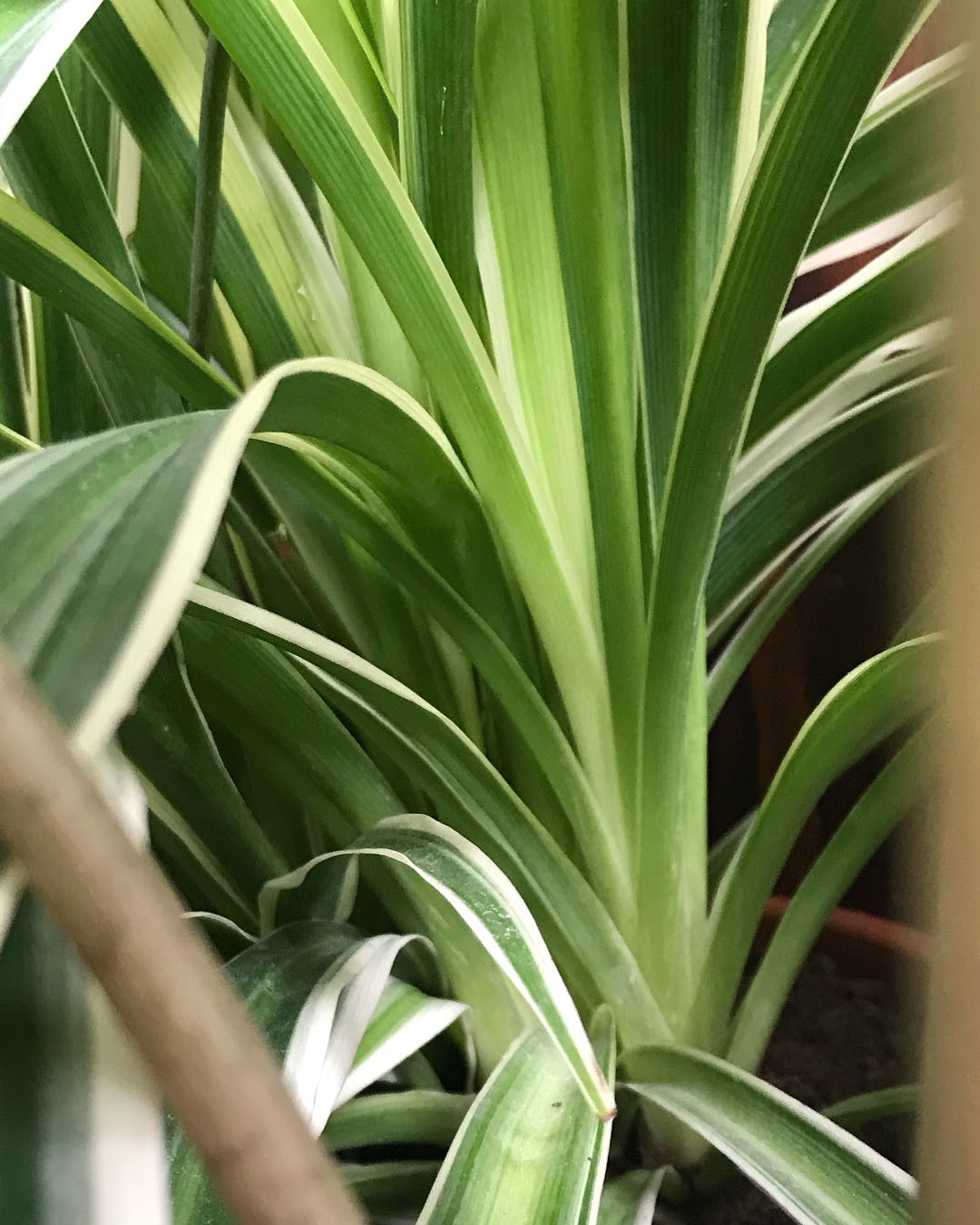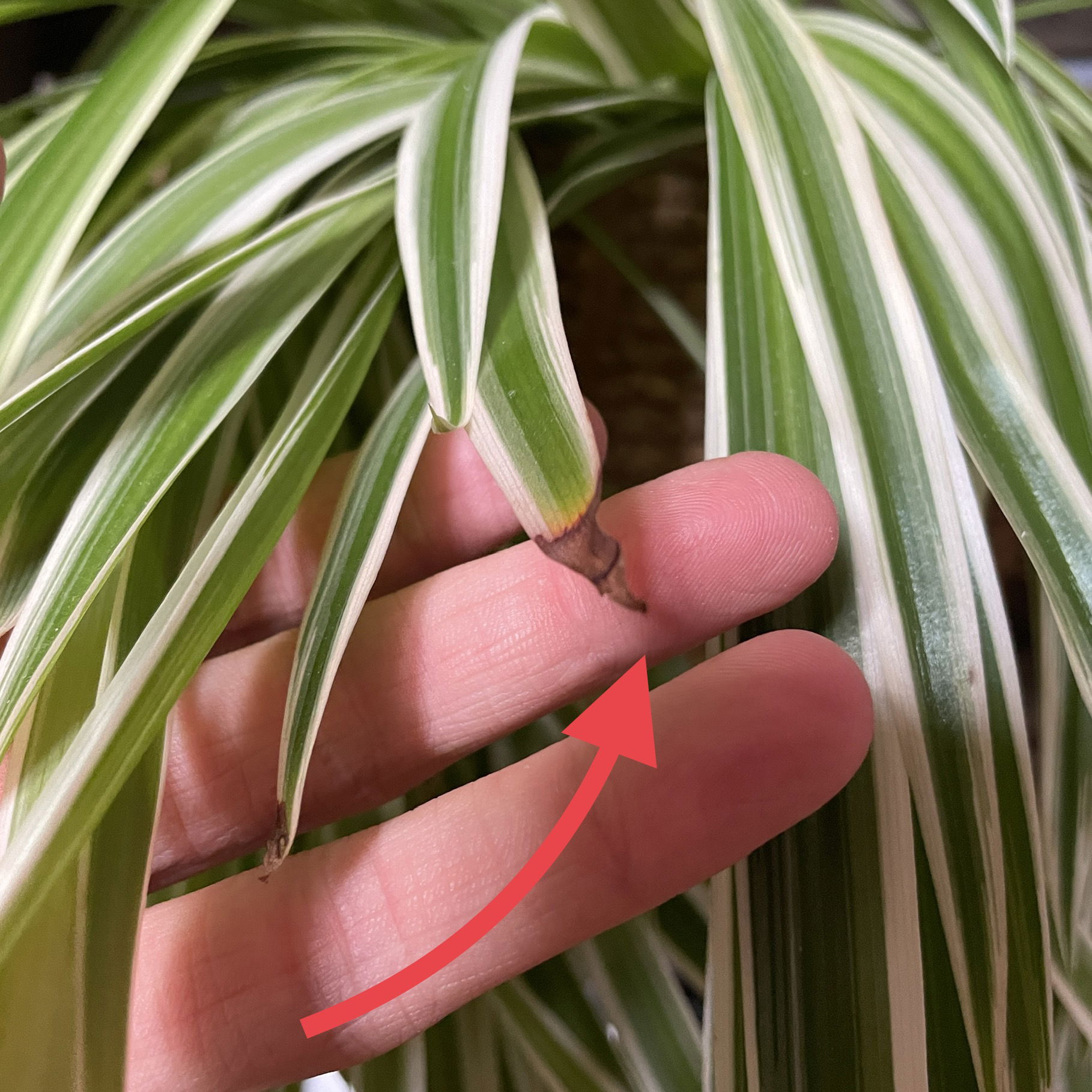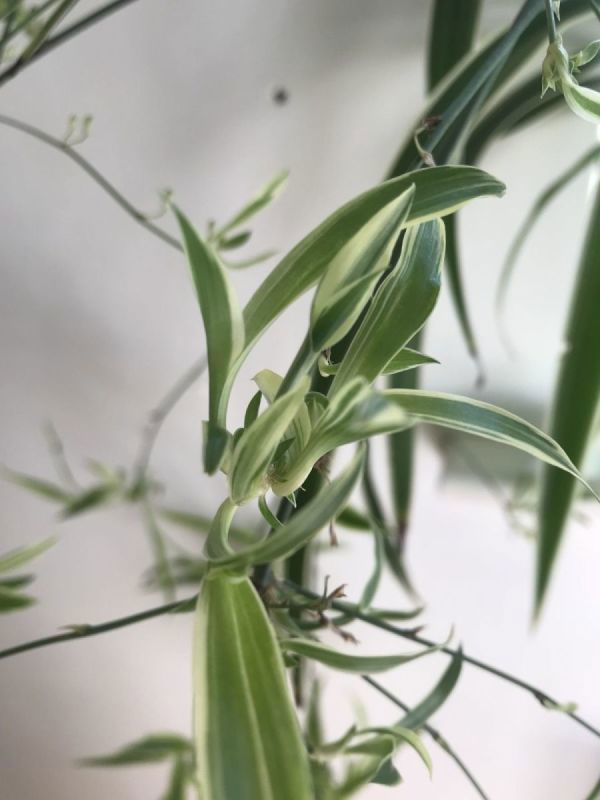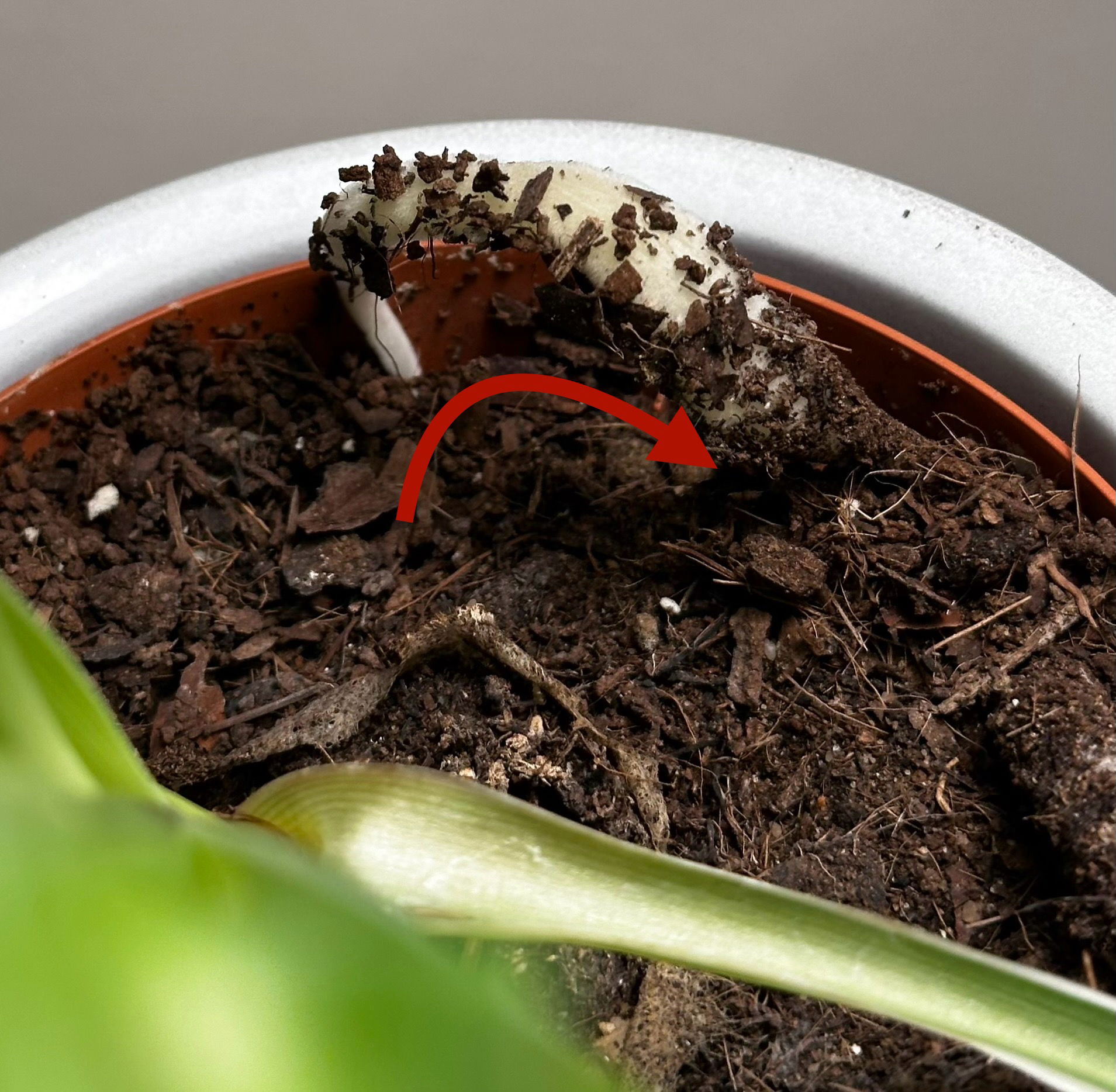
Chlorophytum comosum 'Variegatum'
Contents
- Top Tips
- Light, Water, Humidity & Fertilisation
- Common Issues
- Origins, Temperature, Propagation, Repotting & Toxicity.
Are you struggling to find the answer to your specific plant issue? Book a 1-to-1 video call with THE HOUSEPLANT DOCTOR™, the website's friendly author, to overcome and address your niggling problem! Available on iMessage, WhatsApp, Facebook Messenger & more.
Top Tips & Info
- Care Difficulty - Very Easy
- Spider Plants can thrive in most areas of your home. For best results, provide a bright windowsill with morning or evening sunlight (east or west-facing windows, etc) or conservatories.
- Remember; the darker the location, the less frequently you should be watering your plant to avoid over-watering/root rot.
- Keep the soil evenly moist, allowing the top third to dry out in between waters.
- Although average room humidity is accepted, rinse the foliage once a month in the shower to remove the thin layer of dust from its leaves.
- Fertilise using a 'Houseplant' labelled feed every third water in the spring and summer, reducing this to every fourth water in the colder months.
- Repot every year or two using a 'Cactus & Succulent' potting mix and the next sized pot with drainage holes. You can also propagate the offsets from the 'runners' that appear when the plant is ready to flower; these offsets are referred to as 'spiderettes' in this article.
- Scroll down to 'Common Issues' to learn more about yellow/brown leaf tips, wilted/snapped leaves and other problems that may face a Spider Plant!
Location & Light - 🔸🔸🔸
Bright, indirect light is best; however, an hour of morning sun is highly beneficial, too. Avoid more than three hours of sunlight per day as overhead trees in the wild protect them, and could easily result in sun-scorch if ignored. Spider Plants are an excellent choice for darker locations as long as over-watering is avoided; never relocate a specimen that's acclimatised to bright light into a darker area, as it may cause severe wilting and environmental stress.
Water - 🔸🔸
Allow the top third of the soil to dry out in between waters, reducing this further during the autumn and winter months. As they'll develop thick tuberous root systems to survive prolonged drought in the wild, it's always best to under-water a Spider Plant rather than over-do it. When irrigating, use tepid water to prevent hurting their sensitive roots from the sudden temperature change - if it's too cold for your teeth, it'll be the same with the plant, too! Although rainwater is best, if you decide to use tap water, allow it to stand for 24hrs to eliminate both chloride and fluoride; large quantities of these chemicals will gradually build up in the soil over the oncoming months, damaging both its overall health and the soil quality. Under-watering symptoms include stunted growth, browned leaf edges or spiderette death, which are commonly caused by too much heat / light, forgetfulness or a much-needed transplant. Over-watering symptoms include a mushy centre, severe wilting or a collapsed stem. If you feel over-watering is to blame, remove the affected leaves, mushy roots and replace some of the soil with a fresh batch of houseplant compost. Click here to learn more about rotten roots.
Humidity - 🔸🔸
Introduce a humidity tray to provide a moist and stable environment for your plant. If the surrounding saturation is too low or the heat too high, its leaves may start to brown over and curl, especially in direct sunlight. Hose the foliage down from time to time to hydrate the leaves and keep the dust levels down.
Fertilisation - 🔸🔸🔸
Fertilise your plant every three waters in the spring and summer before reducing this to every fourth drink for the rest of the year. Although 'Houseplant' feed is best, a general purpose fertiliser can be used at half the recommended strength, too. Never over-feed during the colder months as large build-ups of chemical salts may cause root-burn and weakened health.
Common Issues with Spider Plants
If you can't find the answer to your problem, book a 1-to-1 video call with THE HOUSEPLANT DOCTOR™ to put point you in the right direction today!
Browning, yellowing or crispy leaf tips are the biggest problem indoor gardeners will face when growing Spider Plants (see image below). In most cases, this is nothing to worry about as the leaf works hard to photosynthesise for energy production, thus showing signs of 'wear'. Simply prune off the damaged tips to improve its overall appearance. However, in other cases, there may be an issue of nutrient-deficient soil or regular prolonged droughts that is to blame. The best way to remedy both of these issues is by repotting your plant into the next sized pot with a 'Cactus & Succulent' potting mix. Click on the link to have a look at our peat-free soil mix, perfect for your Spider Plant.
Spindly/snapped thin growth could be the sign of too little sunlight or over-watering (commonly go hand in hand). Specimens kept in darker locations must be watered far less than those grown elsewhere, purely based on the photosynthesis and lack of warmth from the sun. Over-watering symptoms include severe wilting, stunted/slowed growth and a rapid loss of older leaves. Allow at least half of the soil to dry out in between irrigations and increase the amount of light to promote better uptake of water through the roots. It's good to note that mature specimens can deal with darker areas far better than newly-bought Spider Plants, purely on the bases of the number of leaves it'll currently hold. So, if you have a young plant, be sure to provide enough light as it gets used to its new home!
White dusty markings on your Spider Plant are just mineral deposits from hard water. If you live in an area with this, try using an aquatic water softener like 'Seachem Prime' that'll remove hard metals, minerals and chlorine. You can also use this to wipe the leaves to remove the dusty markings.
If your healthy Spider Plant has collapsed, wilted, or snapped, it may just be serving its natural dormancy period when exposed to cold room temperatures (below 15℃, 59℉). Similarly to the UK's weather patterns, a Spider Plant's natural habitat in Southern Africa goes through the usual seasonal changes of temperature, light exposure and daylight hours. With this in mind, keep the plant's soil on the drier side to life until new bursts of leaves emerge from its stems which may take a few months. You'll get a fresh looking Spider Plant in no time!
Failed propagated spiderette cuttings - There are several reasons why the cuttings haven't rooted well, including: the time of year (spring or summer is best), its size (cuttings should have at least be 6cm in height), poor growing conditions (replace water weekly for water-propagated cuttings, and avoid over-watering for soil-grown plants), and its growing environment (a bright sunless windowsill and warmth is important).
 Brown, crispy or yellow leaf tips are a common issue with Spider Plants, but don't panic! For the most part, it's a normal part of the individual leaf's maturity as it goes through a dormancy period in the colder months (hence its less-than-perfect appearance!). Look out for a burst of growth in the spring that'll make the plant look perfect again. You can prune the crispy tips off, but make sure you don't cut into the green growth.
Brown, crispy or yellow leaf tips are a common issue with Spider Plants, but don't panic! For the most part, it's a normal part of the individual leaf's maturity as it goes through a dormancy period in the colder months (hence its less-than-perfect appearance!). Look out for a burst of growth in the spring that'll make the plant look perfect again. You can prune the crispy tips off, but make sure you don't cut into the green growth.
Origins
The genus, Chlorophytum has distributions across tropical and subtropical Africa, but has recently been introduced to other areas such as Western Australia, Thailand and Malaysia. C. comosum (the Latin name for a Spider Plant) was first described by Carl Peter Thunberg as 'Anthericum comosum' in 1794, in a book during a visit to South Africa. From this point onwards, the species has been placed in many different genera, including Phalangium and Caesia, but was finally placed in Chlorophytum in the early 1860s. In Greek, its current name, Chlorophytum comosum, translates to 'green plant' with 'tufts of hair' that refers to its growth habits. The roots are eaten in some cultures in India and Iran for a source of protein.
 The Distribution of Chlorophytum comosum (Spider Plants).
The Distribution of Chlorophytum comosum (Spider Plants).
Temperature
7° - 32℃ (44° - 90℉)
H1b (Hardiness Zone 12) - Can be grown outdoors during the summer in a sheltered location with temperatures above 9℃ (48℉), but is fine to remain indoors, too. If you decide to bring this houseplant outdoors, don't allow it to endure any direct sunlight as it may result in sun-scorch. Regularly keep an eye out for pests, especially when re-introducing it back indoors.
Spread
Up to 0.6m in both height and width. The ultimate height will take between 3 - 6 years to achieve, with rapid growth per month. Stolons (or runners) will usually develop within 18 months of purchase or propagation, carrying new spiderette offsets of their own.
Pruning & Maintenance
Remove yellow or dying leaves to encourage a better appearance and overall growing conditions. While pruning, always use clean scissors or shears to reduce the chance of bacterial and fungal diseases. You can cut off the browned leaf tips to improve the plant's look, but the chances are likely that it'll redevelop in a couple of months!
Propagation
Via Seed, Division or 'Spiderettes' (Runners/Offsets)
Division (Easy) - Your plant will produce several basal offsets that can be separated once they have a sufficient root system. If possible, water the soil 24hrs before the main event to reduce the risk of transplant shock, when its dry root systems are over-fingered. Take the plant out of its pot and place your fingers close to the nodal junction - soil may have to be removed for better access. Push the chosen offset downwards until you hear a snap. Separate the foliage and its root system away from the mother plant, mentally noting the high risk of damage. Transplant in the appropriate sized pot with a fresh batch of 'Houseplant' soil. Maintain evenly moist soil and situate it in a bright, indirect location away from any direct sunlight. After four weeks, treat it like a normal Spider Plant, following the care tips above!
 Spiderettes off a stolon (runner)
Spiderettes off a stolon (runner)
Spiderettes (Very Easy) - After around a twelve to eighteen months, your Spider Plants should produce stolons that'll house spiderette offsets and small white flowers. Once the offsets are at least 6cm in height, safely snip them off from the stolon and place in water for a few weeks. Once the root system is a third of the plant's height, it's time to pot it up. Choose a 7cm pot that's has adequate drainage and fill with a 'Cactus & Succulent' potting mix. Submerge the roots and part of cutting's base into the soil and water thoroughly. After the first irrigation, the soil may dip and compact in some areas - this is completely fine and should be filled with the leftover potting mix. Keep the cutting in a bright, indirect location away from direct sunlight and other heat sources whilst it's young. Maintain evenly moist soil, allowing the top layer to become dry in between waters. After two months, treat it the same as you would with the mother plant, following the care tips above!
Flowers
'Runners', or stolons, will develop during spring and summer that'll hold small white flowers and offspring in the form of spiderettes. The flowers will develop in succession along the stolon, lasting up to five days before browning over.
 Spider Plants have a very invasive root system, meaning that they must be repotted annually to prevent damage to the pot. The root system pictured is eighteen months old and far too potbound for its own good.
Spider Plants have a very invasive root system, meaning that they must be repotted annually to prevent damage to the pot. The root system pictured is eighteen months old and far too potbound for its own good.
Repotting
Repot every year in the spring, using 'Cactus & Succulent' potting mix' and the next sized up pot (plastic or terracotta is best).
The three main symptoms of being potbound are slowed growth, browning leaf edges and large, finger-like roots developing through the drainage holes. It's important to regularly increase the pot size to reduce the threat of stressed roots, which in turn may result in poor foliar health (browned leaf tips and wilted/flat growth). If you'd like to be guided with repotting your houseplant, don't be afraid to book a 1-to-1 call with THE HOUSEPLANT DOCTOR™.
 Sometimes, a rogue root strange may try and work its way out of the potting mix at the time. Fear not as it's a good indication your Spider Plant needs repotting soon!
Sometimes, a rogue root strange may try and work its way out of the potting mix at the time. Fear not as it's a good indication your Spider Plant needs repotting soon!
Pests & Diseases
Although they're mostly pest-free, spider mites or fungus gnats could attack at any time. Common diseases associated with Spider Plants are leaf-spot disease, root rot, powdery mildew and botrytis (grey mould) - click here to learn more about these issues.
Toxicity
This plant is slightly poisonous. If parts of the plants are eaten, vomiting, nausea and a loss of appetite may occur. Consumption of large quantities must be dealt with quickly; acquire medical assistance for further information.
Retail Locations
Blue Diamond, Dobbies, British Garden Centres, B&Q, Homebase & Online Stores. Facebook Market should be the first port of call for purchasing a Spider Plant, purely on the basis of cheaper prices when bought as a 'Spiderette' cutting.
Book a 1-to-1 Call with Joe Bagley (THE HOUSEPLANT DOCTOR™)
If you need further advice with your houseplants, book an advice call with ukhouseplants' friendly and expert writer today! This can be done via a video or audio call on most apps, including Facebook, FaceTime & Skype. A ten-minute call costs £5.99 (US$7), or £15.99 for thirty minutes. You can ask multiple questions, including queries on plants, pests, terrariums, repotting advice and anything in between. Please consider supporting this service to keep ukhouseplants thriving!